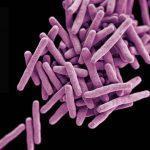Tuberculosis (TB) caused by Mycobacterium tuberculosis (Mtb) is still a deadly infectious disease in many cases despite existing treatment options. About 50% of patients with Tb have a poor lung recovery likely caused by an exacerbated inflammatory response against Mtb prior to diagnosis and treatment.
It is already known that neutrophils are associated with lung pathology in TB but defined neutrophil subsets using the markers CD16 and CD62L have not been studied in TB. Muefong et al. isolated neutrophils from fresh blood of HIV-negative TB patients and stimulated them for two hours with Mtb-specific antigens. They then used flow cytometry to monitor frequencies, phenotype and function of these stimulated neutrophils. The findings were correlated with disease severity as assessed by Chest X-Rays and bacterial load pre- and post-therapy (Further reading: Inflammatory processes define M. tuberculosis infection to TB).
The frequencies of total neutrophils decreased by six months of treatment compared to baseline and the decrease was more significant in patients with severe lung damage. However, the numbers of segmented neutrophils (CD16 bright/CD62L bright; mature neutrophils) increased, whereas the numbers of banded neutrophils (CD16 dim/CD62L bright; immature neutrophils) decreased. These changes in frequencies only occurred in patients with mild lung damage/low Mtb loads suggesting that homeostatic conditions are restored in these patients soon after treatment completion. The number of IL-10+ banded neutrophils increased in patients with severe lung damage, whereas the frequencies of IL-10+ segmented neutrophils decreased in patients with mild lung pathology. This further highlights the differences between these two neutrophil subsets. Taken together, high numbers of banded neutrophils, high levels of IL-10 expressing CD16 dim/CD62L low neutrophils and increased ROS generation play a protective role in TB pathogenesis by limiting lung impairment/reducing Mtb burden.
Interesting reads at Immunopaedia – A novel pathway of immune and host cell evasion by Mycobacterium tuberculosis and Tuberculosis Vaccine Development- Progress in Clinical Evaluation.
Journal Article: Muefong, et al., 2021. Neutrophils contribute to severity of tuberculosis pathology and recovery from lung damage pre- and post-treatment. Clinical Infectious Diseases.
Summary by Dr. Jasmin Knopf (Friedrich-Alexander-University of Erlangen-Nürnberg, Rheumatology and Immunology Clinic)
